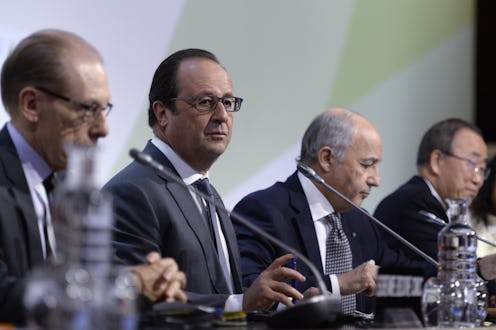News
What Happened At The Paris Climate Talks?
Despite the deadly terror attacks that threatened to put a halt to U.N. climate talks, world leaders gathered in Paris last week, determined to begin discussions over new global policy that would help usher in a new era of renewable energy and try to find workable solutions for global warming. On Saturday, the results of those talks were finally revealed. At the close of the annual session, French Foreign Minister Laurent Fabius unveiled the details behind the U.N.’s “historic” new climate accord made at the Paris talks, signaling a momentous advance in world environmental policy — one that hadn't been reached in similar magnitude since the late '90s.
"Our responsibility to history is immense," Fabius told the crowd of 195 world leaders, which included U.S. Secretary of State John Kerry. “If we were to fail, how could we rebuild this hope? Our children would not understand or forgive us.”
Debates over the accord itself were fraught with tension, as leaders bickered over corresponding details and measures that would bring every country, in various state of development, on board with the sweeping agreements. “Our text is the best possible balance,” explained Fabius. “[It’s] a balance which is powerful yet delicate, which will enable each delegation, each group of countries, with his head held high, having achieved something important.”
Although much of the accord itself is not legally binding — world leaders pledged in good faith to keep to the guidelines as closely as possible in subsequent years — it was the first step in the right direction, and the first official pact made since 1997’s Kyoto Protocol. And while it’s likely to hit a few snags here in the United States (specifically from congressional Republicans like Wyoming Sen. John Barrasso, who lamented in a comment to The Washington Post on Thursday that Americans “[didn’t] want these policies”), the accord sought largely to limit the effects of global warming and protect smaller island nations who might be directly impacted by rising sea levels and economic strain.
Leaders from several regions had initially lobbied for a binding $100 billion per year financial agreement by wealthier nations, in order to assist poorer countries in keeping up with the accord’s soft demands — namely, in order to help them gradually move away from coal-power plants to green-energy efficient sources. Although the $100 billion financial agreement was included in the final text, it did not make it into the segment of the document that is legally binding, causing alarm amongst some financially strapped countries.
“We’ve always said that it was important that the $100 billion was anchored in the agreement,” explained Democratic Republic of Congo negotiator Tosi Mpanu-Mpanu, in a statement to The New York Times. “We’ll have to huddle and see if something can be worked out.”
In broader strokes, the accord also requires nations who have not already done so to agree to “ratify and implement” the Kyoto Protocol, as well as to “aim to reach global peaking of greenhouse gas emissions as soon as possible, recognizing that peaking will take longer for developing [countries].” The initial goal included in the agreements would limit carbon emissions in order to hold “the increase in the global average temperature to well below 2°C above pre-industrial levels and to pursue efforts to limit the temperature increase to 1.5°C above pre-industrial levels.”
In addition to the suggested standards, the accord also employs language that protects indigenous and cultural groups by melding contemporary science with native customs.
“Parties acknowledge that adaptation action should follow a country-driven, gender-responsive, participatory and fully transparent approach, taking into consideration vulnerable groups, communities and ecosystems,” the accord specified. “It should be based on and guided by the best available science and, as appropriate, traditional knowledge, knowledge of indigenous peoples and local knowledge systems, with a view to integrating adaptation into relevant socioeconomic and environmental policies and actions, where appropriate.” Educational initiatives were also stressed.
The time frame included in the accord is 10 to 15 years, or before 2030. By that point, leaders suggested on Saturday, the global community should have had time to change processes and practices enough that scientists would be able to tell if they had made a significant difference. Global leaders will be able to revisit the accord every five years as well, in order to adjust where necessary.
“The agreement will send a powerful, immediate signal to global markets that the clean energy future is open for business,” said Environmental Defense Fund President Fred Krupp, in a statement to The Hill on Saturday, waving off suggestions from varying parties which implied that the accord’s language was too vague to prompt any significant change. “It makes a moral call for dramatic action that leaves no one behind, and it moves us closer to the crucial turning point when global carbon emissions, which have been rising for more than two centuries, finally begin to decline.”
